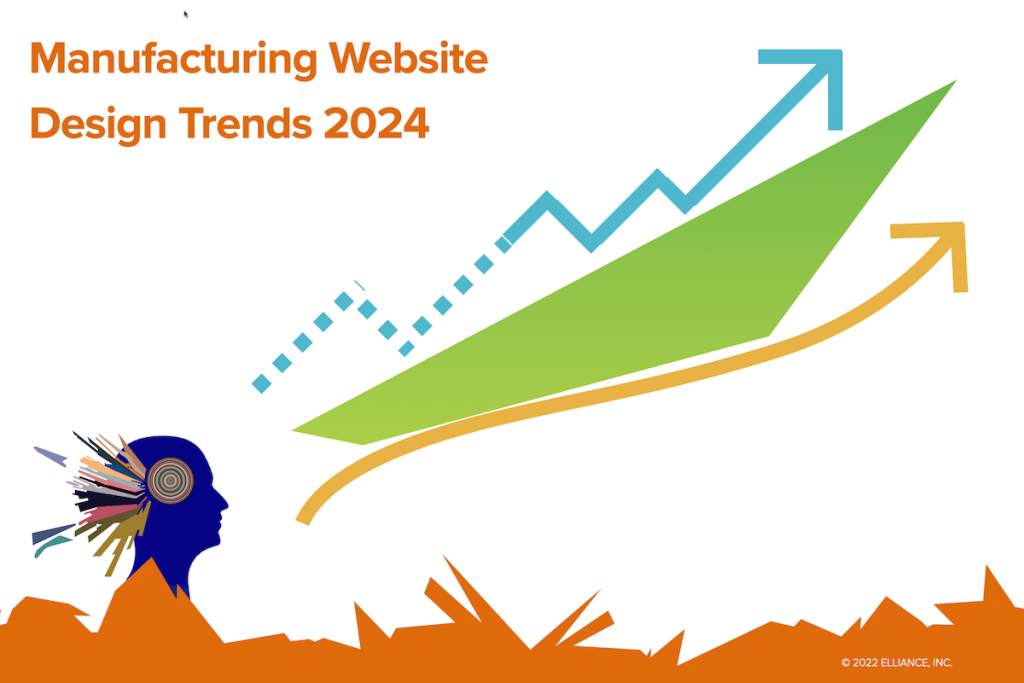| Jan 20, 2024
Manufacturing Website Design Trends for 2024

Macro forces often drive micro actions. This certainly holds true for manufacturing website design trends for the coming year. Our agency sees three primary forces impacting the manufacturing environment:
- First, there has been a generational shift from Boomers to Gen-Xers, Millennials, and Gen-Zers. By 2025, 75% of the global workforce will be largely comprised of Millennials and Gen-Zers. Not only are they digitally savvy, they care deeply about climate change, sustainability, and corporate values.
- Second, in-sourcing and bringing manufacturing back to the US is in full swing. In 2021 and 2022, we saw the passing of three key pieces of legislation: the Infrastructure Investment and Jobs Act (IIJA), the Creating Helpful Incentives to Produce Semiconductors (CHIPS) and Science Act, and the Inflation Reduction Act (IRA). Domestic manufacturing is hot again.
- Third, the era of Industry 4.0 powered by smart factories fitted with AI, robotics, 5G, IoT, data analytics, and cloud computing is here.
These forces are re-shaping the entire manufacturing sector. Since all roads lead back to the corporate website – increasingly recognized as the digital soul of an organization – these macro-economic forces will re-shape manufacturing websites in eight fundamental ways:
1. Purpose First
Since Millennials and Gen-Zers care deeply about corporate values, they are gravitating towards companies that embrace environmental, social and governance (ESG) standards, and embody corporate social responsibility (CSR). Both emerging talent and buyers are attracted to brands which live in accordance with their core values. To create resonance, manufacturing websites must go beyond promoting their expertise and celebrate their corporate commitment to sustainability and communities.
2. Keyword Lexicons First
If a manufacturer can’t be found on page one of Google or Bing, their products can’t be bought. Manufacturing website designers must start their projects in collaboration with SEO marketers who’ll research and assemble crucial search phrases in a Keyword Lexicon. The lexicon should inform all aspects of website design including user experience, information architecture, initial website content, and ongoing content upgrades. Keyword categories in the lexicon should include products/services, brand positioning, reputation, decisioning, and location. Keywords must include the variety of phrases used in the buyer journey and the talent recruitment journey. It is imperative for the website designers to use SEO best practices to ensure that manufacturer’s products and services, thought-leadership content as well as job postings can surface on page one of Google and Bing.
3. Talent Attraction First
The war for attracting and retaining Gen-Zer, Millennial and Gen-Xer talent is on. The only way to address talent shortage is for your job postings to be found on Google page one and to reassure prospective employees that you’ll offer training and professional development. Manufacturing websites must optimize all job listings and spotlight the wealth of opportunities available for personal, professional and career development.
4. New Breed of Buyers First
Smart manufacturing marketers realize that not all customers are born equal. New websites are focused on converting both high-margin strategic buyers and the emerging generation of tactical buyers.
5. Contemporary Design Sensibility First
Manufacturers can’t expect young people to buy from a company with a tired, old manufacturing aesthetic. New buyers are increasingly digitally savvy. To appeal to them, manufacturing websites should consider incorporating nature-inspired organic forms, cool digital design, and interactive energy. They need to convey manufacturing expertise backed by thought-leadership and confident modernity.
6. Reputation First
High-fidelity content is the lifeblood of reputable brands. With assistance from subject matter experts and AI tools, manufacturing marketers will produce high-octane web stories, thought-leadership white papers and informative blog posts — and infuse them with keywords to secure Google page one rankings.
7. Globalization First
Since websites are the #1 tool for global sales, website designers are localizing and optimizing content for various regions where manufacturers can secure the highest sales growth. Websites should naturally allow content to be available in other languages of strategic interest.
8. ROI First
Manufacturing website designers know that they will be held accountable for the basic law of business investment: their efforts must generate an ROI. Website ROI measures include both upstream site metrics – such as reduced bounce rates, increase time on site, ever-widening geographic reach, increased Google/Bing page one rankings – and downstream business metrics – such as increased leads, cross-sell rates, renewal rates, after-sale service rates, and overall impact on total revenue.
In 2024, nimble manufacturers will use these eight trends to secure an unfair share of the market and sales growth.
Looking for a professional manufacturing marketing agency? Review our website design expertise and contact us if you wish to join the elite group of manufacturers enjoying business growth with their websites.
